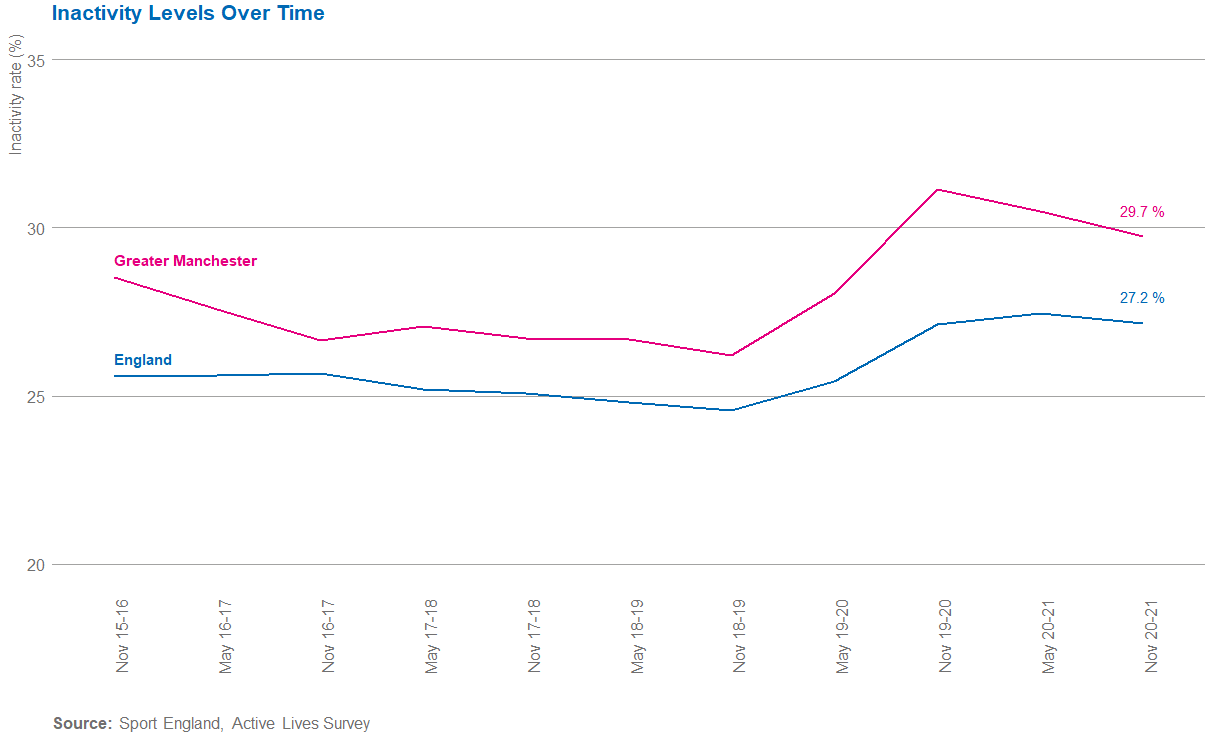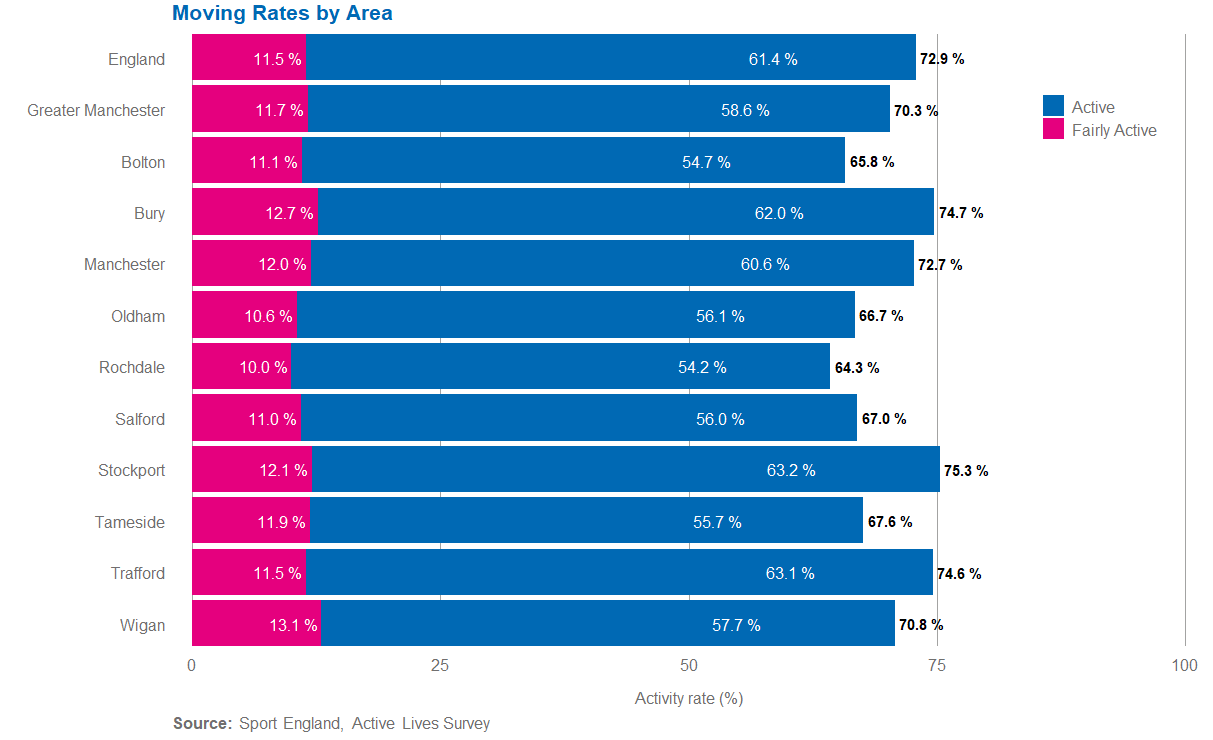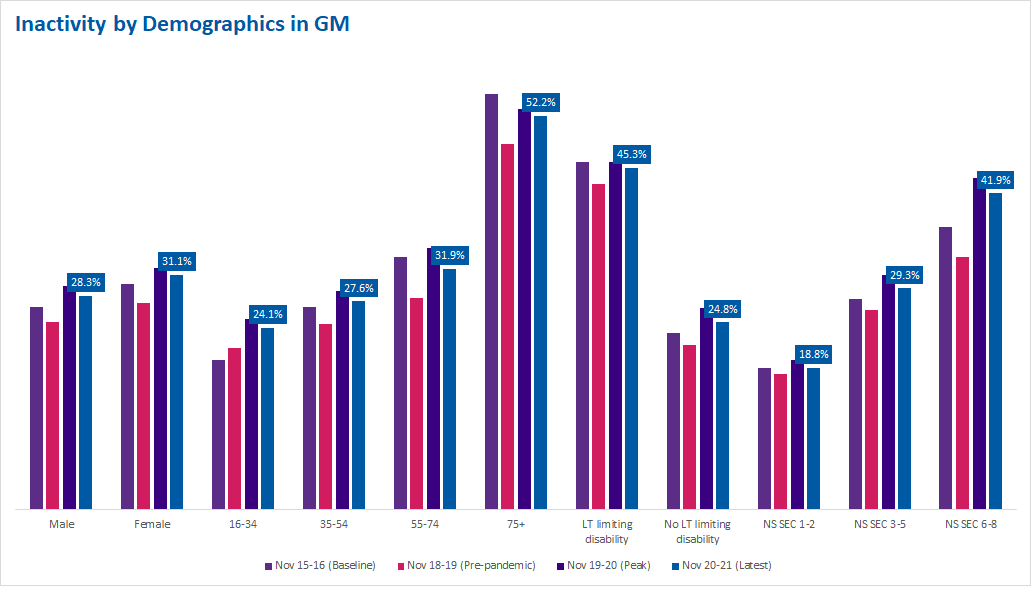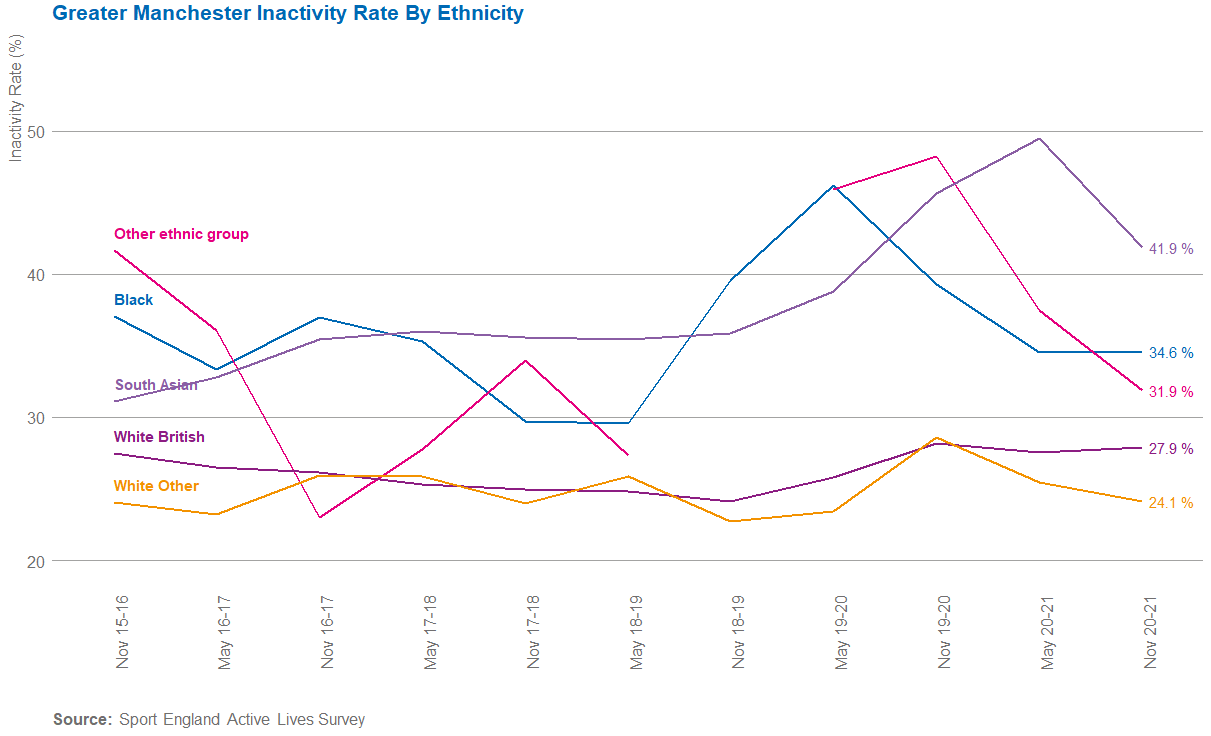Greater Manchester Adult Activity Levels November 2020-21
The latest Active Lives results published by Sport England show that 70.3% of adults in the region are active for at least 30 minutes a week, equating to 1,590,900 adults moving; an increase of 39,000 from the survey 12 months ago.
Greater Manchester Overview
Greater Manchester is showing signs of a faster recovery than nationally at this stage, which is good news because we know we have got further to climb back after a bigger pandemic impact than other places. The inactivity gap between GM and national is closing (from 4% 12 months ago to 2.6%, previously 1.6% in November 2018-19 at its lowest).
Although the trend across all demographics is consistent; inactivity decreased from baseline (November 2015-16) to its lowest pre-pandemic (November 2018-19), then peaked in November 2019-20 and is now showing signs of recovery.
There is a concerning underlying picture, those with a Long term health condition (LTHC) or disability, those aged 75+, from a South Asian ethnicity or from lower socio-economic groups are still most likely to be inactive, with at least 2 out of 5 people from these groups doing less than 30minutes a week.
The biggest concern is those from lower socio-economic groups and South Asian ethnicities, who were most significantly impacted by the pandemic and are showing least signs of recovery, to either baseline or pre-pandemic levels.
How people get their active minutes has continued to change, the time people spend walking for leisure is at an all time high and continuing to rise. But, cycling, fitness activities and walking for travel have all reduced.
Moving Rates
The latest Active Lives data shows that there has been an increase in activity levels across Greater Manchester. 70.3% of adults in Greater Manchester are now moving (active and fairly active), this equates to 1,590,900 adults, in comparison 72.9% of adults are moving nationally.
Inactivity
The inactive proportion has seen its biggest annual decrease (down 1.4% since November 2019-20) and is now at 29.7%. However, this remains higher than pre pandemic levels.
Within the inactive population, almost half a million people (462,500) do nothing! But over 200,000 are either doing something but not enough, or are missing the intensity.

Differences across the boroughs
There remain clear differences in activity levels across the boroughs of Greater Manchester with three boroughs above the national average for moving, Bury, Stockport and Trafford. The gap between the boroughs with the highest and lowest levels of moving now stands at 11.0%, down from 15.6% in November 2019-20, but not as low as 9.8% in November 2018-19.

Demographic data
Mid to older aged adults (35-75+ years) are showing signs of recovery to below baseline levels, but younger adults (16-34 years) are not, despite some signs of recovery from the peak of the pandemic.
Those with a LTHC or disability, as well as those from higher socio-economic groups were less impacted by the pandemic and are showing signs of recovery to baseline. Even if some way to go for those with a LTHC or disability to pre-pandemic levels or especially to GM average levels.
The biggest concern is those from lower socio-economic groups and South Asian ethnicities who were most significantly impacted by the pandemic and are showing least signs of recovery to either baseline or pre-pandemic levels.

 |
The inactivity gender gap in GM is 2.8%Since November 15/16 the gender gap has decreased by 0.3%. This has been driven by a greater increase in inactivity amongst men (+1.5%) than amongst women (+1.1%). |
 |
The inactivity socio-economic gap in GM is 24.1%Since November 15/16 the socio-economic gap has increased by 4.5%. This is a result of no increase in inactivity amongst higher social groups (+0.5%), NS-SEC 1-2, and a large increase amongst lower social groups (+4.4%), NS-SEC 6-8. Learn more about activity levels related to socio-economic status here |
 |
The inactivity disability gap in GM is 20.5%Since November 15/16 the disability gap has decreased by 2.2%. This has been caused by an increase in inactivity amongst those with no long term limiting disabilities (+1.4%) and a decrease in inactivity rates amongst those with long term limiting disabilities (-0.5%). Learn more about activity levels related to disability and long term health conditions here |
 |
The inactivity age gap in GM is 28.1%Since November 15/16 the age gap has decreased by 7.1%. This has been driven by an increase in inactivity amongst 16 to 34 year olds (+4.3%) and a decrease in inactivity amongst over 75's (-2.9%). |
 |
Ethnicity and activity levelsDue to the nature of ethnicity data we do not calculate an inactivity ethnicity gap. South Asians have seen the greatest increase in inactivity since baseline (+10.8%), whilst this has been a steady increase. White British and White Other have also all seen increase in inactivity but to a much smaller degree (+0.5% and +0.1% respectively). Whilst those who identify as Black have seen a decrease since baseline (-2.4%) there has been significant fluctuation in rates of inactivity. Other, chinese and mixed ethnic groups have also seen a decline in inactivity (-9.7%, 4.9% and -8.7% respectively), however, there is not a full timeseries available making it harder to understand the patterns seen. |
|
|
If you have questions about this data or would like access to the raw data please email: [email protected]
All data is rounded to one decimal point.
Published April 2022.

